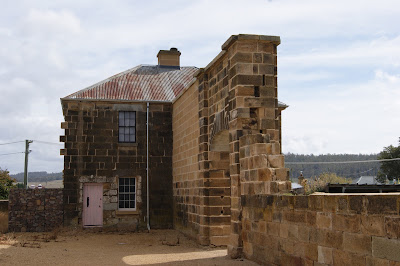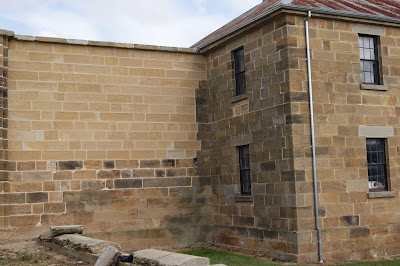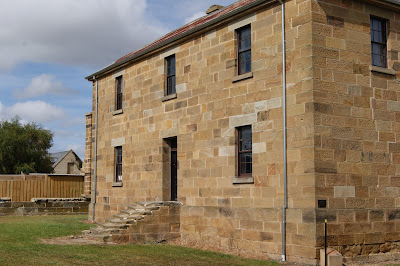A memorandum from Lieutenant Governor George Arthur, dated September 1827, announced the erection of the first gaol at Oatlands. A log-jail, containing four cells for eight men each, will be constructed at Oatlands under the superintendence of Lieutenant Vachell Staff Corps, who will supply the tools from his stores and furnish the carts. A free overseer at a salary not exceeding £25 with 2 carpenters 2 sawyers and eight labourers will be furnished by the Engineer for this work. A small log hut for the Gaoler was commissioned at the same time.


The Gaolers residence was a crudely built hut of logs lashed together. A sod skillion was attached to the rear and the roof pitch was deemed very unsatisfactory, the whole being very low and damp In May 1831, Edward Bolger, Gaoler at Oatlands wrote to the Civil Engineer requesting a new Gaolers residence, as the old one was past service. He also requested repairs to the gaol which had not been repaired since a previous escape attempt. Bolger’s requests apparently fell on deaf ears, and eleven months later the Sherriff’s Office demanded action, reporting “It appears that the Gaol at Oatlands is really in a very dangerous insecure condition, in as much, that any person from the outside could without any difficulty and in very few minutes liberate all the prisoners confined therein.”


John Lee-Archer traveled to Oatlands in May 1832 to inspect the buildings. He reported that the Gaoler’s residence was in a very poor state and barely fit for repair. He recommended contracting repairs to the gaol, which included replacement of several logs and generally securing woodwork and whitewashing Lee-Archer recommended that the entire complex (the Gaol, Gaolers House and Constables House) should be enclosed in an eight-foot high fence, with gates between the residences and gaol


The Oatlands Gaol was opened in 1836 and housed up to 76 prisoners at any one time, both male and female. Prisoners were sent here for various offences, but the longest sentence ever served was only 18 days long. Between 1844 and 1860 a total of eight men were executed at the Gaol. The Gaol was run and organized by a Gaoler and from 1837 to 1878 a total of eight Gaolers were appointed. They and their families lived in the Gaoler’s Residence and shared their home with the prisoners. Three of the Gaolers – William Glover, Peter Pegus and William Gumley – were known to have had children of various ages who lived in the residence from 1838 until 1873. It is not known whether any of the superintendents who resided in the property from 1878 onwards had children.


After 1863 much of the Gaol building was demolished, as it was beyond the needs of a municipal facility. The yard and the solitary cells were demolished in 1937 and in 1954 a public swimming pool was added to the site. The Gaoler’s Residence survived this destruction and some of the outer walls are also still standing. Over the past three years summer archaeological programs have been run at the site by the Southern Midlands Council as part of a larger project to renovate the Gaoler’s Residence. . The archaeological program worked to uncover the men’s yard, the privy, the gallows and the solitary cells, amongst other parts of the old gaol.


The Gaoler and his family lived on the second floor of the Residence, while the first floor was shared between the Gaoler and the prisoners. An 1835 plan shows that the first floor housed two kitchens – a men’s kitchen and a women’s kitchen – as well as a lobby, store room and porter’s room. The second floor housed two bedrooms, the Gaoler’s kitchen, an office and a parlour. During renovations to the Gaoler’s Residence, toys and other domestic artifacts were discovered under the floorboards of the bedroom, kitchen and rear bedroom on the second floor. The roof of the upstairs bedroom had collapsed and the floorboards needed replacing due to water damage. The floorboards were made of Tasmanian hardwood, which expanded and contracted from fluctuations in the weather, and often had large gaps between the boards allowing many artefacts to be lost beneath them.


Underneath the floor archaeologists found more than 100 toys, including four Noah’s Ark animals, a doll’s arm, Frozen Charlotte dolls, chalk, a ceramic doll’s tea pot, and a metal tea cup, a ceramic and a wooden doll’s plate, a vase, a paper puppet, a tennis ball, four dominos, a wooden whistle, and 16 marbles. A study project focused on how the identification of the toys could identify the status of the families, the gender of the children and the use of the rooms in the Gaoler’s Residence. Many of the toys were handmade and have therefore been difficult to identify or date. The Noah’s Arks, for example, were usually hand crafted and, because of their religious significance, often the only toys that children were allowed to play with on a Sunday. Four partial Noah’s Ark animals were recovered from the underfloor deposits: a camel, a weasel, a pig and a hedgehog.


Archeologists have been able to identify positively the date of only one of the toys – an ace of spades printed by the United States Playing Card Co. It is a Bicycle playing card, number 808. The ace of spades depicts the statue of freedom, which in 1865 was placed on top of the Capitol Building in Washington DC. The ace of spades in the Oatlands collection is a racer number 1 series, which was introduced in 1895 and ran until 1906. During this period there were six families living in the Gaol, and the date range of the card spans the majority of their occupation of the Gaol. Three of the families had children; however playing cards were used more by adults than by children. There were 66 other playing cards in the underfloor deposits that are also Bicycle playing cards. These are the 808 series of playing cards and have blue and red patterns on their backs. The 808 series was introduced in 1885.


The Gaoler’s residence, still being almost wholly intact has served a variety of uses since 1938, including a private residence, WWII soldiers base, an art school and public meeting rooms (Country Women’s Association and Rural Youth). The building has served no specific purpose since the early 1980’s, with regular maintenance by the Southern Midlands Council preventing its deterioration, the Oatlands Gaoler’s residence offers significant potential for a variety of future uses.
Main Text & Information Sources –



